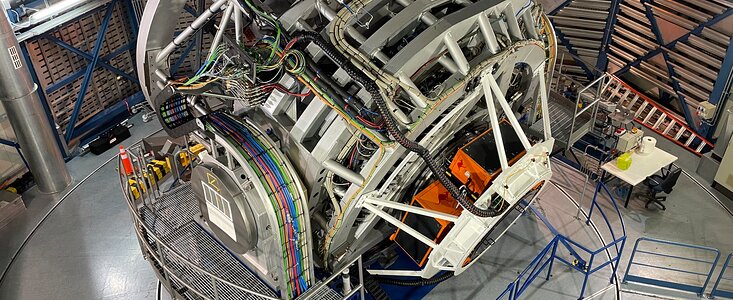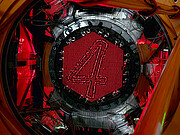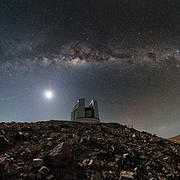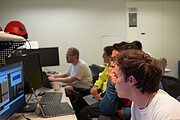Annuncio
Migliaia di occhi rivolti al cielo: 4MOST vede la sua prima luce
21 Ottobre 2025
Nel fine settimana, lo strumento Multi-Object Spectroscopic Telescope (4MOST) da 4 metri ha completato con successo le prime osservazioni di prova. Installato sul telescopio VISTA (Visible and Infrared Survey Telescope for Astronomy), un telescopio dell'ESO in Cile, 4MOST è la più grande struttura del suo genere per l'osservazione dei cieli australi. Si prevede che catturerà e analizzerà la luce di oltre 25 milioni di oggetti diversi durante i primi cinque anni di attività, al fine di, tra gli altri numerosi obiettivi scientifici, svelare la nostra storia galattica, esplorare i misteri della materia oscura e indagare l'origine delle stelle.
Lo strumento è progettato per catturare simultaneamente la luce di migliaia di oggetti cosmici, utilizzando oltre 2400 sottili fibre ottiche, ciascuna dello spessore di un capello umano. La luce raccolta viene quindi indirizzata a tre spettrografi separati che la scompongono nelle componenti di colore, fino a 18.000 nella banda della luce visibile dal viola al rosso, fornendoci spettri individuali con cui gli astronomi possono studiare le proprietà delle sorgenti cosmiche osservate, tra cui la composizione chimica, la velocità e la distanza.
"Gli astronomi chiedevano da tempo una struttura come 4MOST", afferma Joar Brynnel, Responsabile del Progetto 4MOST presso il Leibniz Institute for Astrophysics di Potsdam (AIP), in Germania, l'istituto che ha guidato il consorzio dello strumento. Il numero di oggetti che può osservare contemporaneamente, l'ampio campo di vista (equivalente all'area di 16 volte la Luna piena) e l'elevato numero di colori spettrali che può registrare simultaneamente rendono lo strumento veramente unico.
"È un cambiamento radicale nel nostro lavoro all'ESO: di solito, quando si osserva con uno strumento, si osservano gli oggetti relativi a un singolo studio scientifico per volta", aggiunge Vincenzo Mainieri, Responsabile Scientifico di 4MOST per conto dell'ESO. Tuttavia, grazie all'elevato numero di fibre, lo strumento può osservare sorgenti provenienti da molti progetti scientifici diversi contemporaneamente. Prosegue: "4MOST può supportare 10 o più studi scientifici in parallelo durante una singola osservazione. Questo è un modo per massimizzare la produzione scientifica dello strumento".
Questa struttura all'avanguardia non solo farà luce sulla nostra galassia, ma scruterà anche più lontano, osservando molte galassie diverse, per ricostruire come si formano ed evolvono. Osservando galassie distanti, 4MOST ci aiuterà anche a comprendere meglio la materia oscura, una forma invisibile di materia che permea le galassie e lo spazio tra di esse. Lo strumento sarà anche utilizzato per studiare l'evoluzione dell'Universo stesso, indagando come si espande e cambia nel tempo.
4MOST ha preso il posto dello strumento VIRCAM (VISTA Infrared Camera), che realizzava survey per il telescopio VISTA a partire dal 2008. Poiché 4MOST è uno spettrografo, uno strumento fondamentalmente diverso da una fotocamera, VISTA necessitava di un aggiornamento completo per poterlo ospitare. "Abbiamo dovuto sostituire molte componente del telescopio per adattarlo al nostro strumento, introducendo nuove ottiche di grandi dimensioni, nuove camere tecniche per il controllo del telescopio e infine lo strumento stesso", spiega Brynnel. "L'aggiornamento del telescopio VISTA in vista delle nuove componenti è stato preparato dall'ESO prima dell'arrivo di 4MOST", aggiunge Jean-François (Jeff) Pirard, Responsabile della gestione di 4MOST per conto dell'ESO. "Il telescopio è tornato in servizio durante il primo semestre del 2025, giusto in tempo per accogliere il nuovo strumento 4MOST".
Le osservazioni della prima luce di 4MOST, che hanno coperto un'area di cielo contenente la Galassia dello Scultore e l'ammasso stellare NGC288, dimostrano la capacità di questo strumento all'avanguardia di osservare più bersagli con un campo di vista sorprendentemente ampio e numerose fibre ottiche. Nella prima fase, 4MOST ha raccolto spettri di diverse stelle della Via Lattea e di oltre un migliaio di galassie vicine e lontane, dimostrando le proprie impressionanti capacità.
Roelof de Jong, Ricercatore Principale di 4MOST e responsabile della sezione Via Lattea presso l'AIP, commenta: "È incredibile vedere i primi spettri del nostro nuovo strumento. I dati sembrano fantastici fin dall'inizio e sono di buon auspicio per tutti i diversi progetti scientifici che vogliamo realizzare. Il fatto che possiamo catturare la luce che ha viaggiato a volte per miliardi di anni luce con una fibra di vetro delle dimensioni di un capello è sbalorditivo. Un'impresa incredibile resa possibile solo da un gruppo di sviluppo straordinario. Non vedo l'ora di avere il sistema operativo ogni notte".
Ulteriori Informazioni
Lo strumento 4MOST è progettato, costruito e gestito scientificamente da un consorzio di 30 università e istituti di ricerca in Europa e Australia, sotto la guida del Leibniz Institute for Astrophysics Potsdam (AIP). I principali istituti coinvolti nella costruzione e nella gestione dell'impianto sono:
- Leibniz Institute for Astrophysics Potsdam (AIP), Germania
- Macquarie University / Australian Astronomical Optics (AAO), Australia
- Centre de Recherche Astrophysique de Lyon (CRAL), Francia
- European Southern Observatory (ESO)
- Max Planck Institute for Astronomy (MPIA), Germania
- Max Planck Institute for Extraterrestrial Physics (MPE), Germania
- Nederlandse Onderzoekschool Voor Astronomie (NOVA), Paesi Bassi
- University of Cambridge, Institute of Astronomy (IoA), Regno Unito
- Universität Hamburg (UHH), Hamburger Sternwarte, Germania
- Universität Heidelberg, Zentrum für Astronomie (ZAH), Germania
- University College London (UCL), Regno Unito
Links
- Comunicato stampa di AIP sulla prima luce di 4MOST
- Sito web del consorzio 4MOST
- Pagina di 4MOST sul sito pubblico dell'ESO
- Ulteriori informazioni su 4MOST nel Blog dell'ESO
- Prima luce di 4MOST (video di AIP)
Contatti
Bárbara Ferreira
ESO Media Manager
Garching bei München, Germany
Tel: +49 89 3200 6670
Email: press@eso.org
Anna Wolter (press contact Italia)
Rete di divulgazione scientifica dell'ESO e INAF-Osservatorio Astronomico di Brera
Milano, Italy
Tel.: +39 02 72320321
E-mail: eson-italy@eso.org
Riguardo all'annuncio
| Identificazione: | ann25007 |
Our use of Cookies
We use cookies that are essential for accessing our websites and using our services. We also use cookies to analyse, measure and improve our websites’ performance, to enable content sharing via social media and to display media content hosted on third-party platforms.
ESO Cookies Policy
The European Organisation for Astronomical Research in the Southern Hemisphere (ESO) is the pre-eminent intergovernmental science and technology organisation in astronomy. It carries out an ambitious programme focused on the design, construction and operation of powerful ground-based observing facilities for astronomy.
This Cookies Policy is intended to provide clarity by outlining the cookies used on the ESO public websites, their functions, the options you have for controlling them, and the ways you can contact us for additional details.
What are cookies?
Cookies are small pieces of data stored on your device by websites you visit. They serve various purposes, such as remembering login credentials and preferences and enhance your browsing experience.
Categories of cookies we use
Essential cookies (always active): These cookies are strictly necessary for the proper functioning of our website. Without these cookies, the website cannot operate correctly, and certain services, such as logging in or accessing secure areas, may not be available; because they are essential for the website’s operation, they cannot be disabled.
Functional Cookies: These cookies enhance your browsing experience by enabling additional features and personalization, such as remembering your preferences and settings. While not strictly necessary for the website to function, they improve usability and convenience; these cookies are only placed if you provide your consent.
Analytics cookies: These cookies collect information about how visitors interact with our website, such as which pages are visited most often and how users navigate the site. This data helps us improve website performance, optimize content, and enhance the user experience; these cookies are only placed if you provide your consent. We use the following analytics cookies.
Matomo Cookies:
This website uses Matomo (formerly Piwik), an open source software which enables the statistical analysis of website visits. Matomo uses cookies (text files) which are saved on your computer and which allow us to analyze how you use our website. The website user information generated by the cookies will only be saved on the servers of our IT Department. We use this information to analyze www.eso.org visits and to prepare reports on website activities. These data will not be disclosed to third parties.
On behalf of ESO, Matomo will use this information for the purpose of evaluating your use of the website, compiling reports on website activity and providing other services relating to website activity and internet usage.
Matomo cookies settings:
Additional Third-party cookies on ESO websites: some of our pages display content from external providers, e.g. YouTube.
Such third-party services are outside of ESO control and may, at any time, change their terms of service, use of cookies, etc.
YouTube: Some videos on the ESO website are embedded from ESO’s official YouTube channel. We have enabled YouTube’s privacy-enhanced mode, meaning that no cookies are set unless the user actively clicks on the video to play it. Additionally, in this mode, YouTube does not store any personally identifiable cookie data for embedded video playbacks. For more details, please refer to YouTube’s embedding videos information page.
Cookies can also be classified based on the following elements.
Regarding the domain, there are:
- First-party cookies, set by the website you are currently visiting. They are stored by the same domain that you are browsing and are used to enhance your experience on that site;
- Third-party cookies, set by a domain other than the one you are currently visiting.
As for their duration, cookies can be:
- Browser-session cookies, which are deleted when the user closes the browser;
- Stored cookies, which stay on the user's device for a predetermined period of time.
How to manage cookies
Cookie settings: You can modify your cookie choices for the ESO webpages at any time by clicking on the link Cookie settings at the bottom of any page.
In your browser: If you wish to delete cookies or instruct your browser to delete or block cookies by default, please visit the help pages of your browser:
Please be aware that if you delete or decline cookies, certain functionalities of our website may be not be available and your browsing experience may be affected.
You can set most browsers to prevent any cookies being placed on your device, but you may then have to manually adjust some preferences every time you visit a site/page. And some services and functionalities may not work properly at all (e.g. profile logging-in, shop check out).
Updates to the ESO Cookies Policy
The ESO Cookies Policy may be subject to future updates, which will be made available on this page.
Additional information
For any queries related to cookies, please contact: pdprATesoDOTorg.
As ESO public webpages are managed by our Department of Communication, your questions will be dealt with the support of the said Department.








